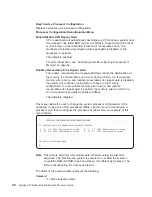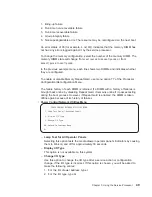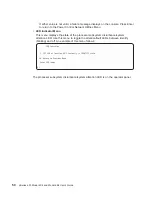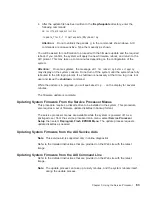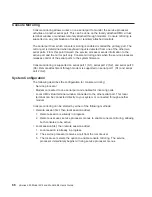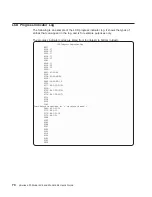
System Power-On Methods
This section discusses the following system power-on methods:
v
Power-on Switch
v
Service Processor Menus
Privileged users can power on the system by selecting the System Control Power
Menu option from the main menu and then selecting the Power-on System option
from the System Power Control Menu. General users should select Power-on
System on the General User Menu.
v
Remote Power-on via Ring-Indicate Signal
The system automatically powers on when it detects a
″
ring indicate
″
signal from a
modem attached to serial port 1 (S1) or serial port 2 (S2).
A remote user can call the system to activate ring detection by the modem. Listen for
a few more rings than the threshold number for starting the system. The system
powers on without answering the call.
v
Unattended start mode - refer to Enable/Disable Unattended Start Mode on page
40.
The service processor can be enabled to recover from the loss of ac power (see
Enable/Disable Unattended Power-On Mode in the SYSTEM POWER CONTROL
MENU). When ac power is restored, the system returns to the power state at the
time ac loss occurred. For example, if the system was powered on when ac loss
occurred, it reboots/restarts when power is restored. If the system was powered off
when ac loss occurred, it remains off when power is restored.
v
Timed power-on - refer to the shutdown -t command on servers using AIX.
Working in conjunction with AIX, the service processor in your system can operate a
timer, much like the wake-up timer on your clock radio. You can set the timer so that
your system powers on at a certain time after shutting down. The timer is
battery-operated, so power interruptions that occur while the system is off do not
affect its accuracy. Refer to the AIX shutdown -t command for details on setting the
timer.
Note: If an ac power loss is in progress when the timed power-on attempt occurs,
the system cannot power on when ac power is restored.
v
Follow-up to a Failed Boot Attempt
The service processor initiates a power-on sequence if a failed boot attempt is
detected (due to a hardware or software failure).
v
Fast or Slow Boot (IPL)
Using the service processor menus, you can select the IPL type, mode, and speed of
your system.
Attention:
Selecting fast IPL results in several diagnostic tests being skipped and a
shorter memory test being run.
58
pSeries 630 Model 6C4 and Model 6E4 User’s Guide
Summary of Contents for 6.00E+04
Page 1: ...pSeries 630 Model 6C4 and Model 6E4 User s Guide SA38 0606 00 ERserver IBM...
Page 2: ......
Page 3: ...pSeries 630 Model 6C4 and Model 6E4 User s Guide SA38 0606 00 ERserver IBM...
Page 14: ...xii pSeries 630 Model 6C4 and Model 6E4 User s Guide...
Page 16: ...xiv pSeries 630 Model 6C4 and Model 6E4 User s Guide...
Page 44: ...26 pSeries 630 Model 6C4 and Model 6E4 User s Guide...
Page 92: ...74 pSeries 630 Model 6C4 and Model 6E4 User s Guide...
Page 108: ...90 pSeries 630 Model 6C4 and Model 6E4 User s Guide...
Page 122: ...104 pSeries 630 Model 6C4 and Model 6E4 User s Guide...
Page 168: ...150 pSeries 630 Model 6C4 and Model 6E4 User s Guide...
Page 174: ...156 pSeries 630 Model 6C4 and Model 6E4 User s Guide...
Page 190: ...172 pSeries 630 Model 6C4 and Model 6E4 User s Guide...
Page 200: ...182 pSeries 630 Model 6C4 and Model 6E4 User s Guide...
Page 224: ...206 pSeries 630 Model 6C4 and Model 6E4 User s Guide...
Page 231: ......
Page 232: ...IBMR Printed in U S A August 2002 SA38 0606 00...



